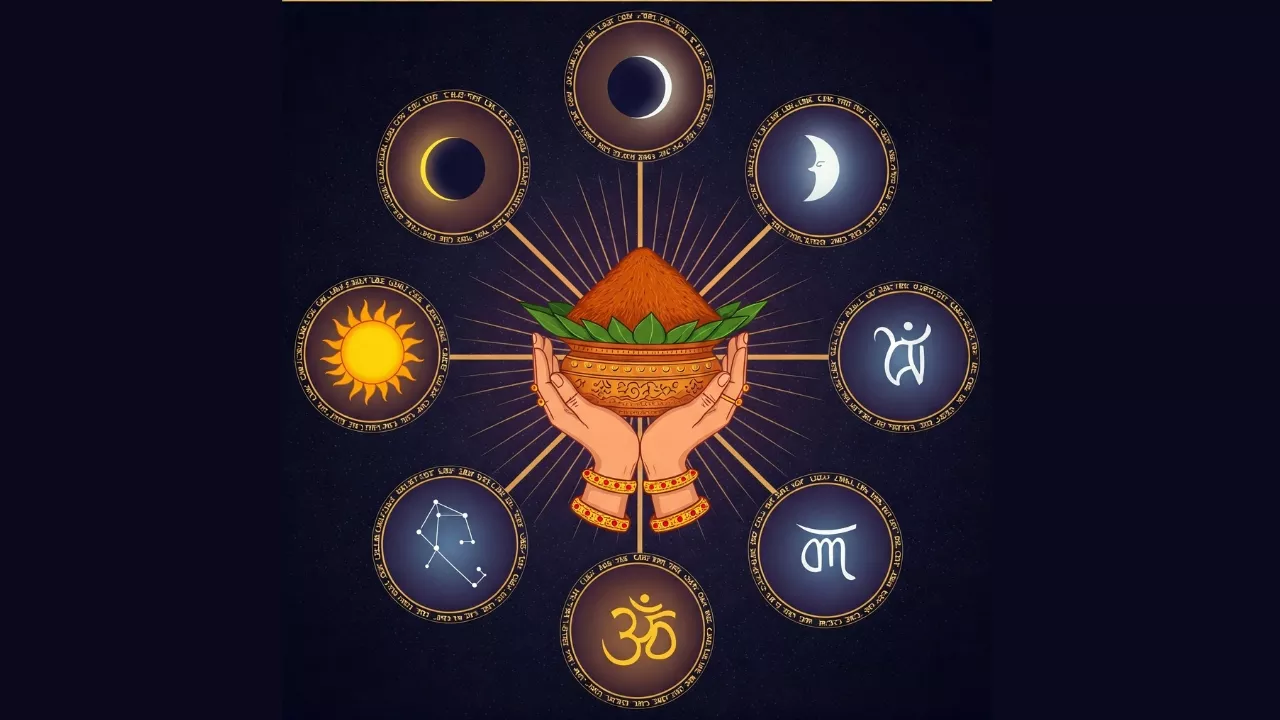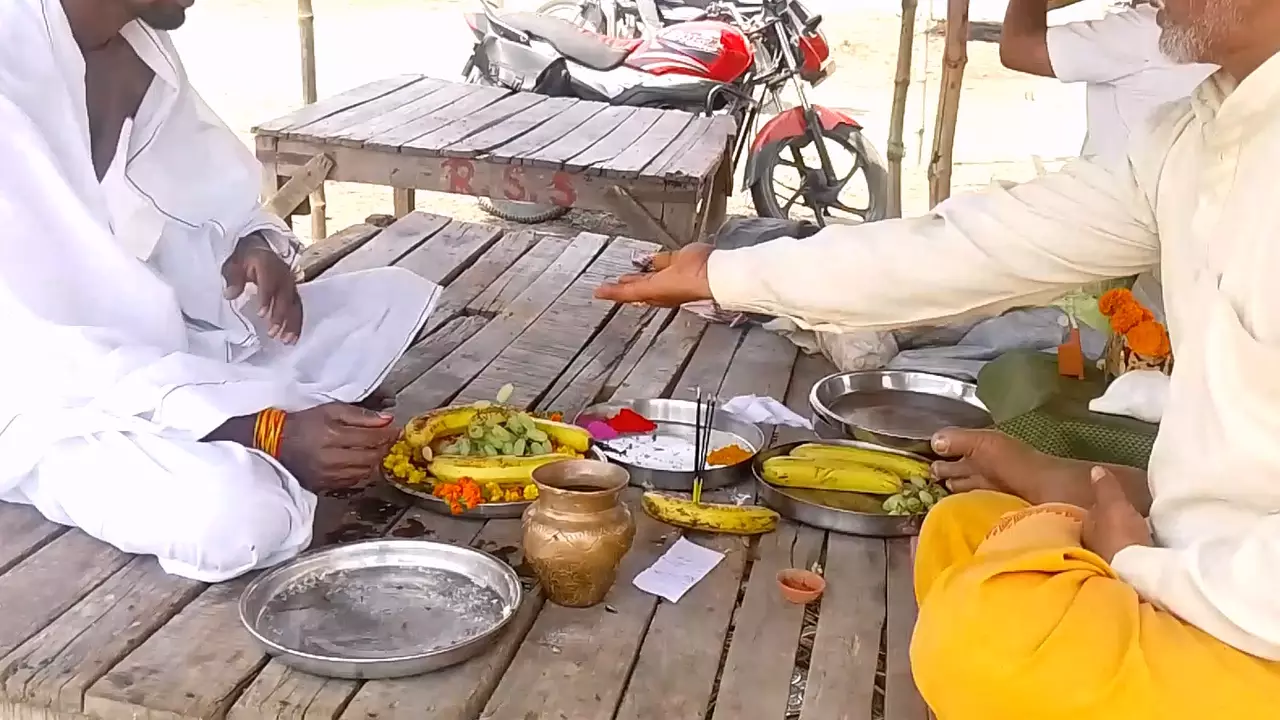Namaste,
Our wise ancestors, guided by the Puranas and Dharmashastras, understood that the connection with our Pitris is a continuous thread, and provided numerous other auspicious occasions throughout the year for us to strengthen this bond and seek their blessings. Knowing when to perform Shradh beyond Pitrupaksha allows for a more consistent practice of remembrance and duty.
Not Just Pitrupaksha: Other Important Times to Perform Shradh for Ancestors
Think of Pitrupaksha as the grand annual gathering for the ancestors, but there are also monthly observances, specific anniversaries, celestial events, and joyous occasions that call for their remembrance and blessings through Shradh rites.
Regular Monthly Observance: Amavasya Shradh

The most frequent and significant time for Shradh outside of Pitrupaksha is the Amavasya, or the New Moon day, occurring each lunar month.
- Puranic Mandate: The Brahma Purana clearly states that Shradh should be performed every month on the Amavasya day. This regular observance keeps the connection with the Pitris active. The Skanda Purana reinforces this, stating that feeding Brahmanas at the conjunction of the sun and moon (Amavasya) yields infinite fruit (ananta phalam) for the Shradh. The Padma Purana also lists the new moon alongside eclipses as suitable times.
- Why Amavasya? Amavasya is considered the day when the Pitris are closest to the earthly realm and are particularly receptive to offerings. It’s seen as their ‘monthly day’. Performing Shradh or at least Tarpana (water libations) on Amavasya is a highly recommended practice for maintaining ancestral well-being and receiving their blessings throughout the year. This makes Amavasya a key answer to the question of when to perform Shradh.
The Personal Connection: Annual Death Anniversary Shradh (Samvatsarik / Kshaya Tithi)
This is perhaps the most personal and important Shradh for an individual ancestor after the initial post-death rites are completed.
- Marking the Departure: This Shradh is performed annually on the tithi (lunar day, according to the Panchangam) on which the individual passed away. The Markandeya Purana confirms that the Shradh for a single deceased person (Ekoddista) should be performed on this specific day of death. The Garuda Purana also mentions performing Shradh on this anniversary date.
- Significance: This rite specifically honours the journey of that particular soul. It is a focused act of remembrance and offering directed towards the individual parent, grandparent, or other close relative on the anniversary of their departure from the physical world.
- Timing Considerations: The Skanda Purana provides nuances, advising against performing the annual Shradh in an intercalary month (Malamasa) and suggesting that for a Brahmin, it should ideally be performed when the Sun is in the same zodiac sign (Rashi) as it was at the time of death.
Harnessing Cosmic Energies: Shradh During Eclipses and Celestial Alignments
Certain astronomical events are considered exceptionally potent times for spiritual practices, including Shradh. The heightened cosmic energies are believed to amplify the effects of the rituals.
- Solar and Lunar Eclipses (Grahana): Performing Shradh during a solar (Surya Grahana) or lunar (Chandra Grahana) eclipse is highly praised in the Puranas. The Brahma Purana mentions performing Parvana Shradh (for multiple ancestors) during eclipses. The Varaha Purana lists eclipses alongside solstices and equinoxes as potent times. The Padma Purana also includes eclipses. The period of the eclipse is seen as a powerful window for spiritual activities, making offerings exceptionally effective.
- Solstices and Equinoxes (Ayana & Vishuva): The Varaha Purana mentions the solstices (when the Sun reaches its northernmost or southernmost point – Uttarayana and Dakshinayana) and the equinoxes (when day and night are equal – Vishuva) as auspicious times for Shradh. These mark significant transitions in the Sun’s apparent journey and are considered energetically charged.
- Samkranti: This marks the Sun’s transit from one zodiac sign (Rashi) to the next, occurring monthly. Certain Samkrantis, especially Makara Samkranti (mid-January), are considered very auspicious for Tarpana and Shradh. The Padma Purana mentions Samkranti as a suitable time.
- Vyatipata Yoga: This is a specific astrological combination considered highly suitable for Shradh, mentioned in the Brahma Purana and Varaha Purana. Performing Shradh during Vyatipata Yoga is believed to yield immense and lasting merit.
Marking Cosmic Cycles: Yugadi and Manvadi Tithis

These dates mark the beginning of cosmic ages (Yugas) and the reigns of the Manus (progenitors of humanity within a cosmic cycle), representing fresh starts in the vast expanse of cosmic time.
- Puranic Recommendation: The Agni Purana states that Shradh performed on the first days of Yugas or Manvantaras yields undiminishing fruits (akshaya phala). The Skanda Purana identifies these specific tithis:
- Kartika Shukla Navami (Start of Treta Yuga)
- Vaishakha Shukla Tritiya (Start of Krita/Satya Yuga – Akshaya Tritiya)
- Magha Amavasya (Start of Kali Yuga)
- Bhadrapada Krishna Trayodashi (Start of Dvapara Yuga)
- Significance: Performing Shradh on these cosmically significant dates aligns the individual act with the grand cycles of creation and dissolution, making the offerings particularly powerful and meritorious. Knowing these dates provides further answers to when to perform Shradh.
Auspicious Lunar Days (Tithis) and Months
Beyond Amavasya and the death anniversary tithi, certain other lunar days and months are highlighted for their special benefits when Shradh is performed.
- Specific Tithis for Specific Boons: The Skanda Purana details the unique merits associated with performing Shradh on various tithis (like Dvitiya for beauty, Tritiya for progeny, Chaturthi for removal of obstacles, Panchami for prosperity, etc., up to Chaturdashi for those killed by weapons). This allows individuals to perform Shradh on specific days based on desired outcomes or the nature of the ancestor being honoured. The Agni Purana also lists specific auspicious days like Ashwayuja Shukla Navami and Kartika Shukla Dwadashi.
- Auspicious Months: While Bhadrapada (for Pitrupaksha) is paramount, months like Magha, Vaishakha, and Kartika also hold significance for ancestral rites, often linked to holy baths and charity performed in the ancestors‘ names.
Shradh on Joyous Occasions: Vrddhi Shradh (Nandi Shradh)
Shradh is not solely associated with somber remembrance; it is also performed during auspicious and happy family events to seek ancestral blessings for success and prosperity.
- Occasions: This type of Shradh, often called Nandi Shradh or Abhyudayika Shradh, is performed before major life events (samskaras) like a son’s birth (Jatakarman), naming ceremony (Namakarana), sacred thread ceremony (Upanayana), marriage (Vivaha), and before starting significant religious vows or sacrifices. The Garuda Purana and Padma Purana mention its performance, for instance, at the birth of a son.
- Purpose: Here, the intention is slightly different. It’s performed to seek the blessings of the ancestors (represented as Nandimukha Pitris) for the auspiciousness and smooth conduct of the upcoming event, ensuring their goodwill and participation in the family’s joy and progress.
The Power of Place: Tirtha Shradh
Performing Shradh at sacred pilgrimage sites (Tirthas) is considered exceptionally meritorious, amplifying the benefits manifold.
- Significance: Holy places like Gaya (considered the most important), Prayagraj (Allahabad), Varanasi (Kashi), Rameshwaram, Badrinath, Dwarka, Pushkar, and the banks of sacred rivers like Ganga, Yamuna, Narmada, Godavari, etc., are believed to be highly conducive to ancestral rites.
- Puranic Praise: The Agni Purana lists ancestral rites at Gaya as a path to liberation. The Garuda Purana and Skanda Purana extensively praise the power of Tirtha Shradh, stating it can liberate ancestors across many generations and grant immense merit to the performer. Therefore, undertaking a pilgrimage specifically to perform Shradh is a highly recommended practice.
Initial Rites and Transitions: Nava Shraddhas and Sapindikarana

These are specific Shradh rites performed in the period immediately following death and marking a crucial transition for the departed soul.
- Nava Shraddhas: As detailed in the Garuda Purana, these are the nine (or sometimes more, like the Shodasha Masik Shraddhas over the first year) initial rites performed within the first 10-12 days after death to help the preta (departed spirit) form a subtle body and begin its journey.
- Sapindikarana: Mentioned in the Garuda Purana and Brahma Purana, this rite formally unites the preta with the Pitris, usually performed on the 12th day or at the end of the first year. This marks the end of the preta stage and the soul’s entry into the Pitriloka, after which regular Shradh (like annual and Amavasya Shradh) begins for that individual as a Pitri.
Conclusion: A Calendar of Remembrance
Our tradition provides a rich calendar for honouring our ancestors, extending far beyond the well-known Pitrupaksha. Understanding when to perform Shradh reveals opportunities scattered throughout the year:
- Monthly: Amavasya (New Moon)
- Annually: Death Anniversary (Kshaya Tithi)
- Cosmically Significant: Eclipses, Solstices, Equinoxes, Samkrantis, Vyatipata Yoga, Yugadi/Manvadi days
- Auspicious Tithis: Various specific lunar days for specific benefits
- Life Events: Before major happy occasions (Vrddhi/Nandi Shradh)
- Pilgrimages: At sacred Tirthas (Tirtha Shradh)
- Post-Death: Initial rites (Nava Shraddhas) and transition rite (Sapindikarana)
By incorporating these observances into our lives, even in simple forms like Tarpana or charity in the ancestors’ names, we maintain a vibrant connection with our lineage, fulfill our sacred duty, and continually invite the invaluable blessings of our Pitris for peace, prosperity, and spiritual progress.
|| कल्याणमस्तु ||
